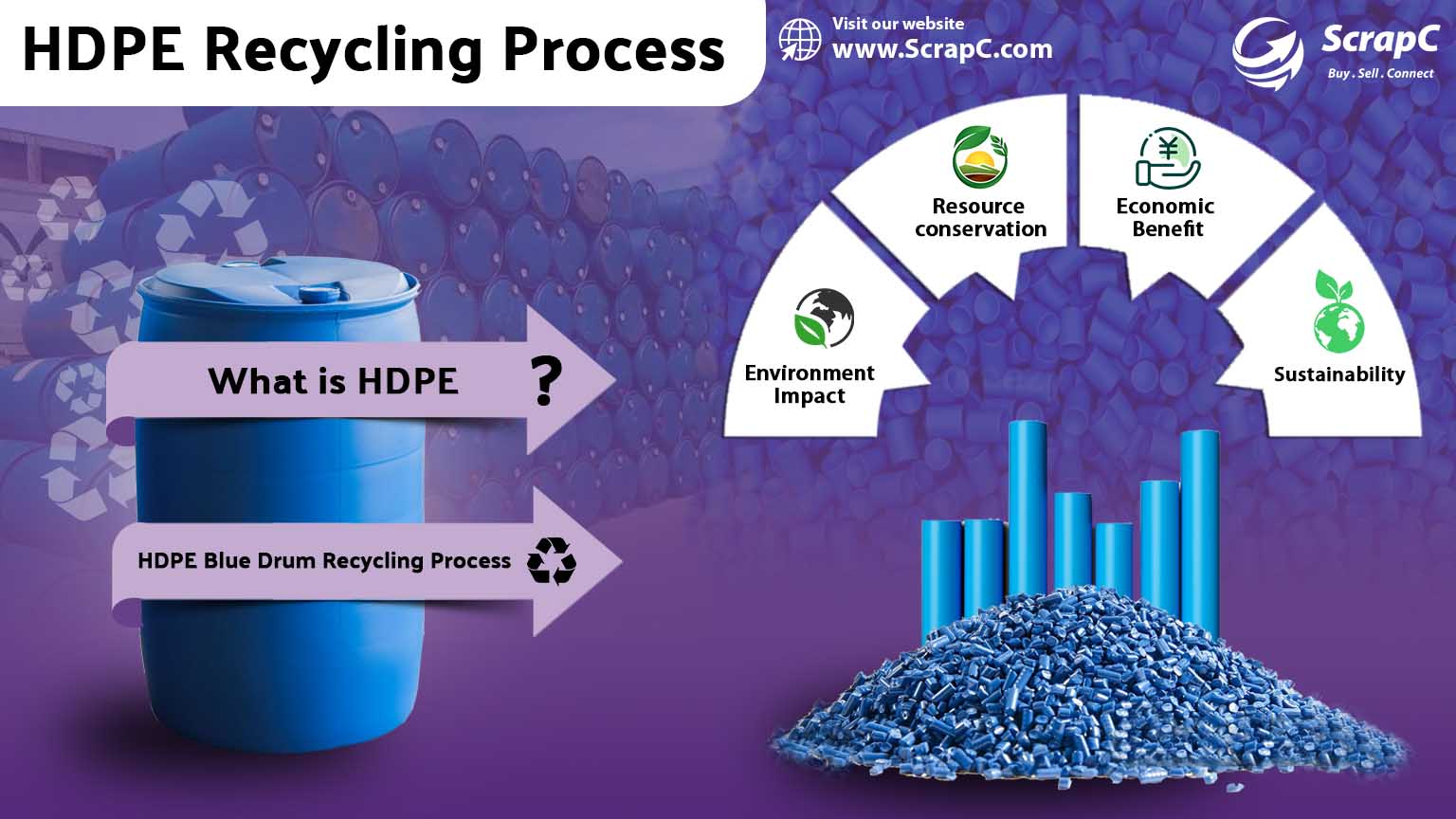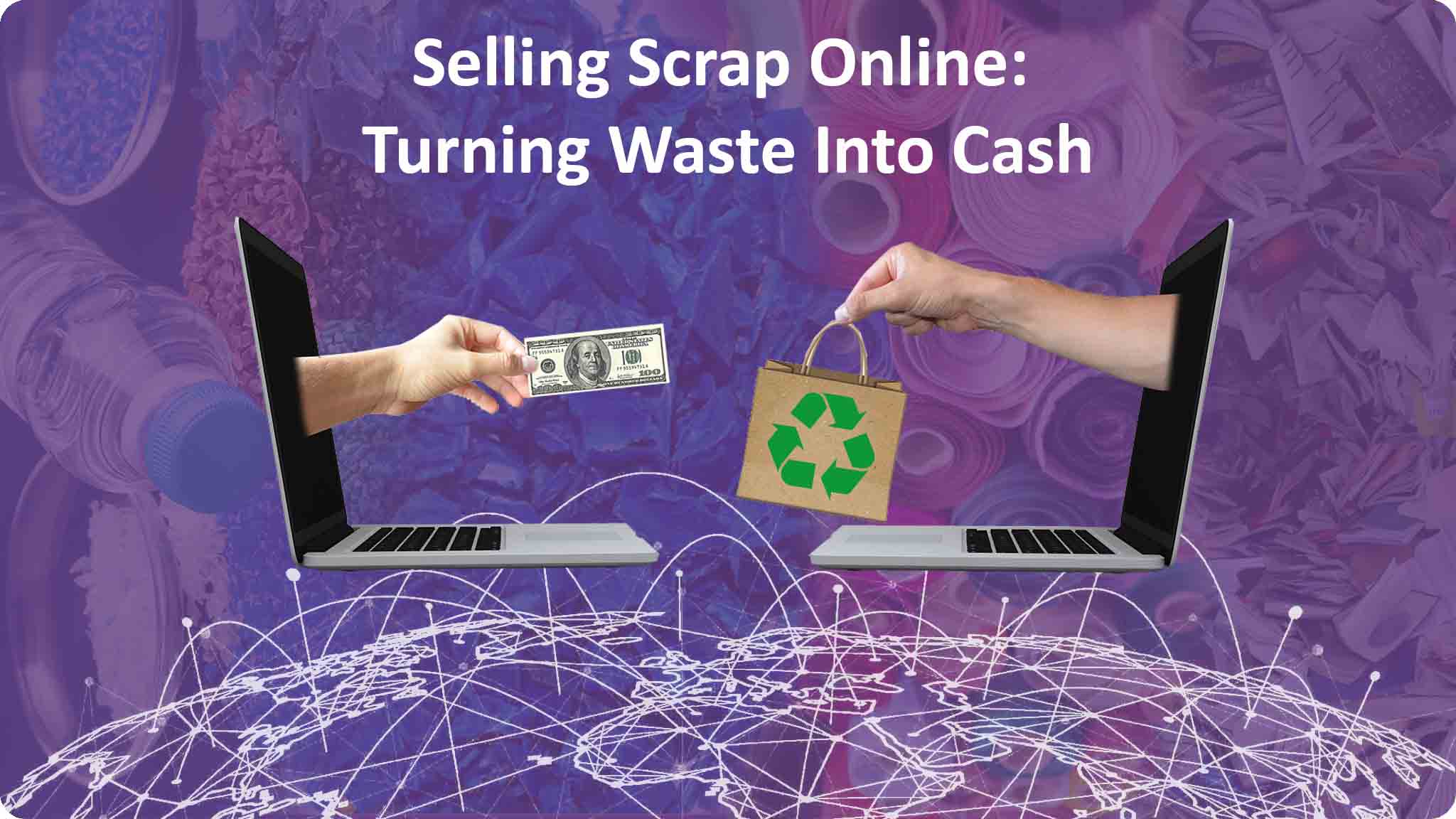Introduction to E-Waste

Electronic waste (e-waste) refers to discarded electrical or electronic devices that are no longer in use. Mobile phones, computers, laptops, printers, and white goods like freezers, washing machines, dryers, home entertainment systems, stereo systems, toys, toasters, and kettles are all included in this broad term.. Any household or business item with circuitry or electrical components powered by electricity or batteries that has been discarded by its original user qualifies as e-waste.
The situation in India is particularly alarming due to the rapid adoption of technology and the short lifespan of electronic devices, but e-waste is a developing concern on a global scale. The absence of efficient recycling infrastructure and public awareness exacerbates the problem, leading to environmental degradation and health risks.
E-waste in India: There are 569 authorized dismantlers and recyclers in the country with a combined annual processing capacity of 1,790,348 tonnes per annum (TPA). Further, the E-waste (Management) Rules, 2020 have authorized registration of 3,430 producers and 124 recyclers on the e-waste Extended Producer Responsibility (EPR) portal.
India: Third Largest E-Waste Producer
India is the third largest e-waste producer globally, generating around 2 million tonnes of e-waste annually. A significant portion of this waste comes from computer equipment (70%), while smaller amounts come from the telecom sector, medical equipment and electrical appliances. Most e-waste is produced by the corporate and public sectors (75%), while households contribute only 16%.
Regional disparities in e-waste generation
Maharashtra, Tamil Nadu and Andhra Pradesh lead in e-waste generation, with Mumbai, Delhi and Bengaluru among the top cities. Urban areas contribute over 60% of the country’s e-waste.
Seelampur: India’s largest e-waste dump yard
Seelampur in east Delhi is the hub of India’s e-waste processing, where 57% of informal units are located. Workers, including women and children, often earn less than Rs 500 a day by extracting metals from discarded electronics under hazardous conditions.
Importance of E-Waste Management in India
The growing number of old electronic devices that people throw away makes e-waste management in India very important. Improper disposal of e-waste causes environmental pollution and health risks, as harmful chemicals such as lead, mercury, and cadmium can leach into the ground and water. Recycling and disposing of electronic waste in a proper manner is an important part of managing it well so that it does not harm the earth and valuable resources can be preserved. Creating jobs in the recycling industry is another benefit. India needs to make e-waste management a top priority to ensure that everyone has a clean and safe future. Information technology is becoming more and more common.
For those who want to contribute to recycling efforts or Sell and Buy Scrap Materials, sell or buy your scrap online. Scrap Marketplace provides an easy and efficient platform for recycling. Join us in making sustainable choices for a better future.
Categorization of E-Waste
The European Council classifies e-waste into the following types:
1 Large Household Appliances:
This includes bulky items such as refrigerators, washing machines, and air conditioners, which are often discarded due to malfunction or obsolescence.
2 Small Household Appliances:
These are smaller items like toasters, kettles, and coffee machines that are frequently replaced due to upgrades or wear and tear.
3 IT and Telecommunications Equipment:
This category covers computers, laptops, mobile phones, and related peripherals, representing a significant portion of e-waste due to the fast-paced evolution of technology.
4 Consumer Equipment:
Home entertainment systems, stereo systems, and other similar electronic devices fall under this category, often discarded as newer models become available.
5 Industrial Tools:
Tools used in various industries containing electronic components, often discarded when they become outdated or fail.
6 Lighting Equipment:
Includes items like fluorescent tubes, compact fluorescent lamps, and LED bulbs, which are frequently replaced due to their finite lifespan.
7 Toys, Leisure, and Sports Equipment:
Electronic toys, fitness machines, and other related equipment fall into this category, contributing to the e-waste stream when they become obsolete or non-functional.
8 Medical Devices:
This includes medical equipment used in healthcare settings, excluding all implanted and radiotherapy devices. These are often discarded due to technological advancements.
9 Monitoring and Control Instruments:
Devices used for monitoring and control purposes in various settings, often replaced as technology improves.
10 Automatic Dispensers:
Machines that dispense products automatically, such as vending machines, often discarded when they become outdated or break down.
Health Hazards and Environmental Impact
The improper disposal of e-waste poses serious health hazards and environmental risks. Some of the key issues include:
1 Toxic Substance Exposure:
Workers in the informal recycling sector are often exposed to harmful chemicals such as lead, mercury, cadmium, and brominated flame retardants, which can lead to respiratory issues, skin diseases, and other serious health problems.
2 Environmental Contamination:
Toxic substances from e-waste can leach into the soil and water, contaminating local ecosystems and posing risks to both human health and wildlife.
Water Pollution:
The process of recovering metals from cables and wires often involves burning, which releases hazardous chemicals like brominated flame retardants and chlorine dioxide (ClO2). These toxic substances can seep into underground water sources, degrading groundwater quality and making it unsafe for human consumption and agricultural use.
Air Pollution:
Burning e-waste to extract metals releases toxic fumes into the air. These fumes contain harmful substances that contribute to air pollution, posing serious health risks such as respiratory issues and cancer in both humans and animals.
Soil Pollution:
When e-waste is discarded in landfills, toxic elements like lead (Pb), mercury (Hg), cadmium (Cd), arsenic (As), and polychlorinated biphenyls (PCBs) seep into the soil. This contamination makes the soil toxic and unsuitable for farming, impacting food safety and agricultural productivity.
Hazardous Waste Disposal:
During the recycling process, elements with no economic value are often discarded carelessly. These poisonous materials can further contaminate soil and water, creating long-term environmental hazards.
3 Impact on Human Health:
Exposure to toxic substances in e-waste can lead to a range of health problems, including neurological damage, respiratory issues, and an increased risk of cancer.
E-Waste Management in India: Challenges and Opportunities
India faces unique challenges in managing e-waste due to several factors:
1 Predominance of the Informal Sector:
A significant portion of e-waste recycling in India is handled by the informal sector, with many low-income households relying on scavenging and recycling for their livelihood. These informal recyclers often lack the necessary safety equipment and knowledge, leading to hazardous working conditions and environmental contamination.
2 Role of Kabadiwalas:
In urban India, middle-class households often sell recyclable materials like paper, plastic, and metal to small, unregulated buyers known as ‘kabadiwalas,’ who then sort and sell these materials to small-scale processors. This informal network, while efficient in collecting waste, lacks proper channels for safe disposal and recycling, leading to environmental hazards.
3 Lack of Formal Collection Systems:
India lacks a structured and widespread system for the collection and recycling of e-waste. Thousands of urban households are involved in the informal e-waste industry, engaging in activities like collecting, categorizing, repairing, refurbishing, and disassembling discarded electronics, often without any formal regulatory oversight.
4 Consumer Behavior:
Unlike in developed countries, there is no widespread practice of consumers donating unwanted electronics to formal recycling centers or paying for the disposal of their e-waste. This lack of awareness and infrastructure leads to improper disposal, often in landfills or by burning, exacerbating the environmental impact.
5 Absence of Structured Disposal Mechanisms:
The lack of formalized e-waste disposal systems contributes to the challenges of managing electronic waste in India. Many consumers are unaware of how to properly dispose of their e-waste, leading to improper disposal methods that harm the environment.
New Approaches to E-Waste Management in India
To address the growing e-waste crisis, India needs to adopt innovative recycling approaches and strengthen its regulatory frameworks. Some of the new approaches that can be implemented include:
1 Formal Recycling Facilities:
Establishing and promoting formal recycling facilities with proper safety standards can help manage e-waste more effectively. These facilities should be equipped with the latest technologies for safe and efficient recycling.
2 Public Awareness Campaigns:
Educating the public about the importance of proper e-waste disposal and the risks associated with improper handling is crucial. Public awareness campaigns can help change consumer behavior and encourage the use of formal recycling channels.
3 Policy and Regulatory Frameworks:
Strengthening regulations and ensuring their enforcement is essential for managing e-waste effectively. India needs to adopt strict regulations for the disposal and recycling of e-waste, with penalties for non-compliance.
4 Extended Producer Responsibility (EPR):
EPR mandates that producers take responsibility for the entire lifecycle of their products, including end-of-life disposal. By making manufacturers responsible for the disposal of their products, EPR can incentivize the development of more sustainable products and reduce the envionmental impact of e-waste.
5 Adoption of Advanced Recycling Technologies:
The use of advanced recycling technologies can help improve the efficiency of e-waste recycling and reduce its environmental impact. Technologies such as automated sorting systems, advanced machinery for material recovery, and data management systems for tracking e-waste can enhance the overall efficiency of the recycling process.
Recycling of E-Waste: Processes and Technologies

The recycling of e-waste involves several key processes, each designed to recover valuable materials and minimize environmental impact. These processes can be broadly divided into two main stages: collection and manual processing, and mechanical and selective treatment.
I) Collection and Manual Processing
1 Collection:
The first step in the e-waste recycling process involves collecting e-waste from various sources, including households, businesses, and public collection centers.
2 Sieving and Sorting:
Once collected, e-waste is screened and categorized by material type. This initial sorting is crucial for efficient recycling and material recovery.
3 Purifying:
Contaminants are removed from the e-waste, ensuring that only valuable materials are processed further.
4 Offloading and Disassembling:
E-waste is then transferred to recycling facilities where devices are broken down into their individual components.
5 Categorizing:
The disassembled components are further classified based on the materials they contain, allowing for targeted recycling.
II) Mechanical and Selective Treatment
1 Mechanical Treatment:
In this stage, e-waste is shredded and pulverized into smaller pieces. This process facilitates the separation of different materials and the recovery of valuable metals.
2 Selective Treatment:
Specialized techniques, such as chemical processing or electrolysis, are used to extract valuable materials like gold, silver, and copper from the shredded e-waste.
Role of Technology in E-Waste Recycling

Technology plays a critical role in ensuring efficient and sustainable e-waste recycling. Some of the key technological advancements that can be applied include:
Automation:
Automated sorting and disassembly processes can greatly enhance the efficiency of e-waste recycling by decreasing the reliance on manual labor and reducing the likelihood of errors.
Advanced Machinery:
The use of advanced machinery for shredding and material recovery can enhance the recycling process, making it more efficient and cost-effective.
Data Management Systems:
Implementing data management systems for tracking e-waste can help streamline the recycling process and ensure that valuable materials are recovered and reused.
Environmental Impact Reduction:
Technologies that reduce the environmental footprint of e-waste recycling, like emission control systems and energy-efficient equipment, are crucial for promoting sustainable recycling practices.
Advantages and Disadvantages of E-Waste Recycling
Advantages:
1 Conservation of Natural Resources:
Recycling e-waste allows for the recovery of valuable materials like gold, silver, and copper, reducing the need for mining and conserving natural resources.
2 Reduction in Pollution:
Proper e-waste recycling reduces the release of harmful substances into the environment, helping to mitigate pollution.
3 Decreased Landfill Usage:
Recycling e-waste reduces the amount of waste sent to landfills, helping to conserve landfill space and reduce environmental impact.
4 Job Creation:
The E-waste recycling industry creates jobs, particularly in the formal sector, contributing to economic development.
5 Prevention of Long-Term Harm:
By properly managing e-waste, the long-term environmental and health risks associated with improper disposal can be mitigated.
Disadvantages:
1 Toxic Leachate:
Improper recycling methods can lead to the release of toxic substances into the environment, contaminating soil and water sources.
2 Space Requirements:
Recycling facilities require significant space for sorting, processing, and storing e-waste, which can be a challenge in densely populated areas.
3 Product Longevity Issues:
Frequent Recycling of electronic devices can lead to a reduction in product longevity, as newer models are often less durable than older ones.
4 Unsafe Practices:
In the absence of proper regulations and safety standards, e-waste recycling can involve unsafe practices that pose risks to workers and the environment.
5 Health Risks:
Workers in the e-waste recycling industry, particularly in the informal sector, are often exposed to harmful substances that can lead to serious health problems.
6 Environmental Impact:
The recycling process itself can have environmental impacts, particularly if not properly managed. For example, the use of chemicals in material recovery can lead to pollution.
7 Contribution to Global Warming:
The energy-intensive nature of e-waste recycling, particularly in the recovery of certain materials, can contribute to global warming.
8 Toxicity of E-Waste:
Even with proper recycling, some e-waste contains highly toxic substances that are difficult to manage and pose long-term risks.
TOP 20 E-Waste Recycling Industry in India

| Company Name | Address |
| 1) Recyclers for ASH | No. 3 KSSIDC Industrial Estate, Hosakote, Bangalore – 562114 |
| 2) Hass Zero Waste | MCHS Colony, Stage 2, BTM Layout In Bengaluru, Karnataka 560076 |
| 3) Indian Companies That Recycle E-Waste | Okhla Industrial Area Phase-I, New Delhi-110020 |
| 4) Ecoverva | 11th Floor of BPTP Park Centra, Sector 30 NH8, Gurgaon, Haryana 122001 |
| 5) GREEN | Electronics Niketan 6, CGO Complex, Lodhi Road, New Delhi 110003 |
| 6) Reecollab | 39, 2/1, Kacholi Road, Jatangla, Rohana Kalan, Uttar Pradesh 251202 |
| 7) EAI | Nungambakkam High Road, Chennai – 600034, Tamil Nadu, |
| 8) Smart Analytica | BSI Business Park, H-15, Sector 63, Noida, UP 201301 |
| 9) IT Solutions Technics Pvt. Ltd. | Darya Ganj, 4648/21 Dayanand Rd, Daryaganj, New Delhi, Delhi 110002 |
| 10) Ecoreco | The Summit Business Bay, Andheri Kurla Road, Andheri (East), Mumbai – 400093. |
| 11) Hitachi Vantara | APMC Market Sector-19 Vashi Navi, Mumbai-400705 |
| 12) Ecotech Reusing | Bandra Kurla Complex, Bandra (East), Mumbai, Maharashtra 400051 |
| 13) SK TES | Villawood NSW 2163, Chester Hill NSW 2162 |
| 14) Green IT | near Perugate and above the Lazzat Hotel Sadashiv Peth in Pune, India, 411030 MH |
| 15) Cosmos Recycling | New Grain Market, Gill Road, Ludhiana, Punjab, India – 141001 |
| 16) Recycling Villa | Near Shree Neel Kanth Rice Sheller, Ludhiana – 141112, Punjab, India |
| 17) Spas Recycling | Roshan Apt, Opp. Holy Spirit Hosp, M C Rd, Andheri (E), Mumbai- 400093 |
| 18) GreenTek Repair | C-129, Naraina Industrial Area, Phase 1, New Delhi – 110028 |
| 19) The RSG group | Sonawala Cross Lane No. 2, Goregaon(E), Mumbai-400063. |
| 20) SATO Asia Pacific | Unit No. 106, Tower B, Unitech Cyber Park, Sector 39, Gurgaon 122 003, Haryana, India |
List of CPCB-Registered Dismantlers/Recyclers. Pdf
E-waste Global Monitor Report
Source : The Global E-waste Statistics Partnership
E-waste Status in Africa in 2022
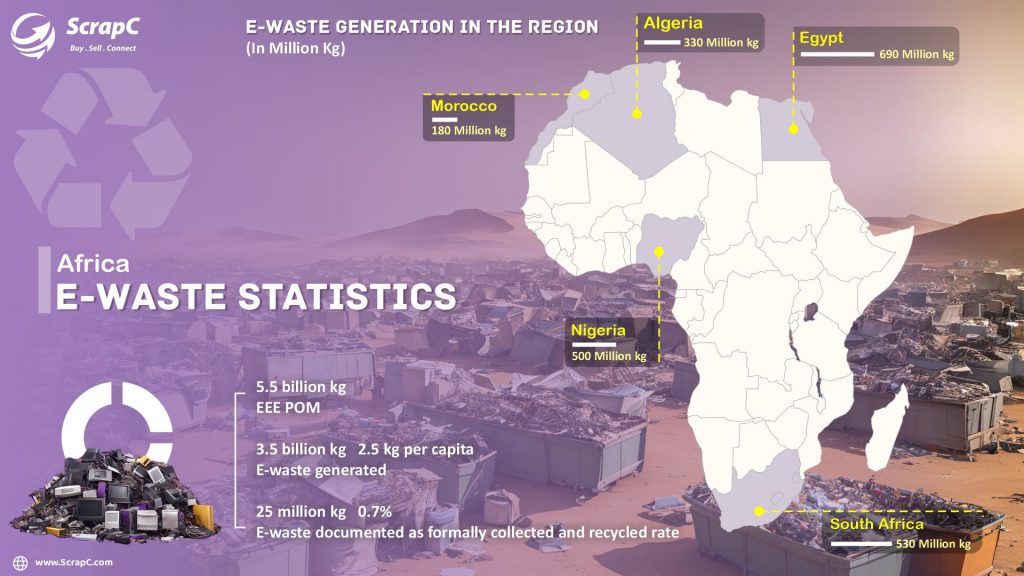
| Eastern Africa | 470 million | Central Africa | 190 million |
| E-waste generated 430 collected and recycled rate 2.4 | 0.5% | E-waste generated 310 collected and recycled rate 0.1 | 0% | ||
| E-waste (million kg) | E-waste (million kg) | ||
| Ken | 88 | Angola | 150 |
| Ethiopia | 88 | Congo, Democratic Rep. of the | 56 |
| Tanzania, United Republic of | 61 | Cameroon | 33 |
| Northern Africa | 260 million | Southern Africa | 68 million |
| E-waste generated 1,500 collected and recycled rate 0 | 0% | E-waste generated 580 collected and recycled rate 23 | 4% | ||
| E-waste (million kg) | E-waste (million kg) | ||
| Egypt | 690 | South Africa | 530 |
| Algeria | 330 | Botswana | 23 |
| Morocco | 180 | Namibia | 17 |
| Western Africa | 260 million |
| E-waste generated 750 collected and recycled rate 0 | 0% | |
| E-waste (million kg) | |
| Nigeria | 500 |
| Ghana | 72 |
| Côte doloire | 42 |
E-waste Status in the Americas in 2022

| Carribean | 32 million | Central America | 190 million |
| E-waste generated 240 collected and recycled rate 0.1 | 0% | E-waste generated 1,800 collected and recycled rate 60 | 3% | ||
| E-waste (million kg) | E-waste (million kg) | ||
| Dominican Republic | 100 | Mexico | 1,500 |
| Puerto Rico | 65 | Guatemala | 92 |
| Trinidad and Tobago | 24 | Costa Rica | 66 |
| Northern America | 32 million | South America | 440 million |
| E-waste generated 8,000 collected and recycled rate 4,100 | 52% | E-waste generated 4,400 collected and recycled rate 230 | 52% | ||
| E-waste (million kg) | E-waste (million kg) | ||
| United States of America | 7,200 | Brazil | 2,400 |
| Canada | 770 | Argentina | 520 |
| Colombia | 390 |
E-waste Status in Asia in 2022
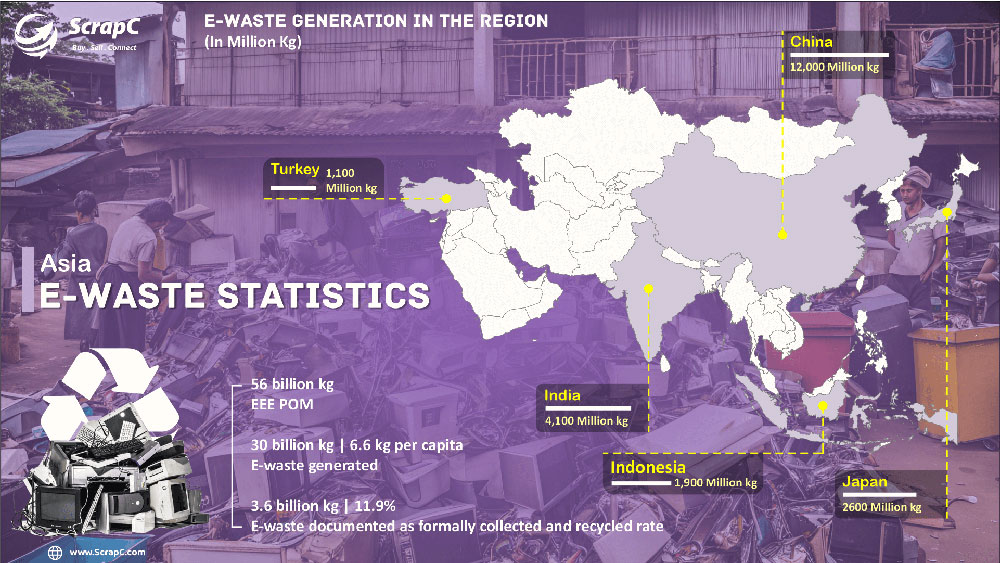
| Central Asia | 76 million | Eastern Asia | 1,600 million |
| E-waste generated 400 collected and recycled rate 13 | 3.2% | E-waste generated 16,000 collected and recycled rate 3,200 | 20% | ||
| E-waste (million kg) | E-waste (million kg) | ||
| Kazakhs | 200 | China | 12,000 |
| Uzbeikstan | 130 | Japan | 2,600 |
| Turkmenistan | 4 | Korea, Republic of | 930 |
| South-Eastern Asia | 680 million | Southern Asia | 2,000 million |
| E-waste generated 4,400 collected and recycled rate 0 | 0% | E-waste generated 6,100 collected and recycled rate 60 | 1% | ||
| E-waste (million kg) | E-waste (million kg) | ||
| Indonesia | 1,900 | India | 4,100 |
| Thailand | 750 | Iran | 820 |
| Philippines | 540 | Pakistan | 560 |
| Western Asia | 290 million |
| E-waste generated 3,000 collected and recycled rate 270 | 9.1% | |
| E-waste (million kg) | |
| Turkey | 1,100 |
| Saudi Arabia | 620 |
| Iraq | 270 |
E-waste Status in Europe in 2022
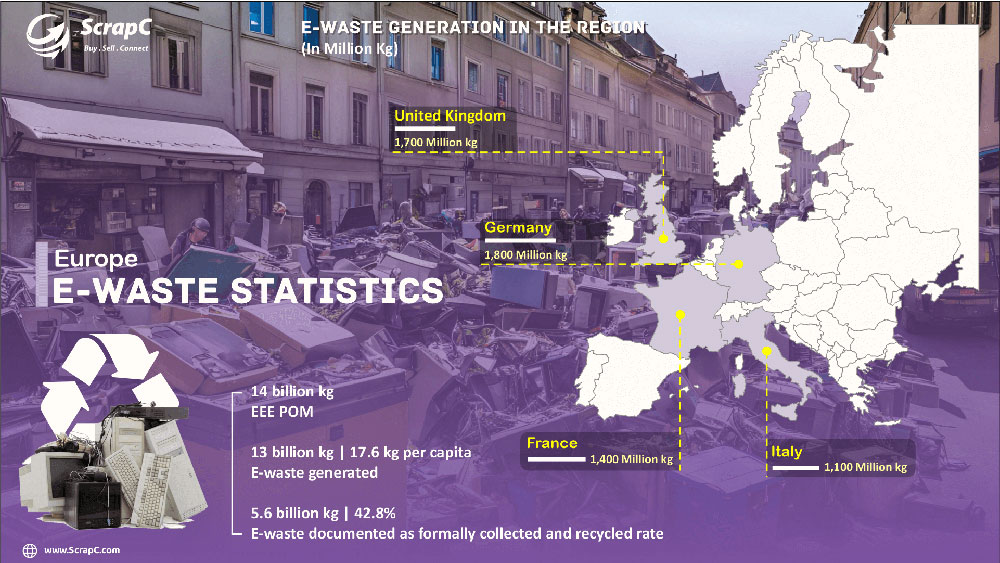
| Eastern Europe | 290 million | Northern Europe | 100 million |
| E-waste generated 3,700 collected and recycled rate 1,000 | 27% | E-waste generated 2,500 collected and recycled rate 1,000 | 42% | ||
| E-waste (million kg) | E-waste (million kg) | ||
| Russian Federation | 1,900 | United Kingdom | 1,700 |
| Poland | 520 | Sweden | 220 |
| Ukraine | 390 | Norway | 140 |
| Southern Europe | 150 million | Western Europe | 200 million |
| E-waste generated 2,700 collected and recycled rate 1,100 | 40% | E-waste generated 4,200 collected and recycled rate 2,500 | 58% | ||
| E-waste (million kg) | E-waste (million kg) | ||
| Italy | 1,100 | Germany | 1,800 |
| Spain | 930 | France | 1,400 |
| Greece | 190 | Netherlands | 390 |
E-waste Status in Oceania in 2022
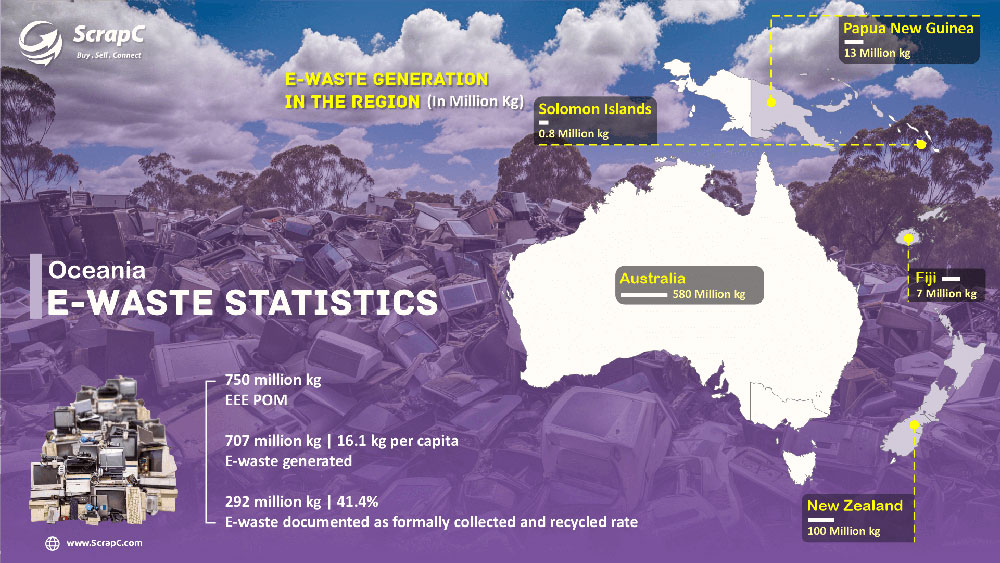
| Australia and New Zealand | 31 million | Melanesia | 12 million |
| E-waste generated 680 collected and recycled rate 290 | 43% | E-waste generated 21 collected and recycled rate 0 | 0% | ||
| E-waste (million kg) | E-waste (million kg) | ||
| Australia | 580 | Papua New Guinea | 13 |
| New Zealand | 100 | Fiji | 6.7 |
| Solomon Islands | 0.8 |
| Micronesia | 0.3 million | Polynesia | 0.3 million |
| E-waste generated 0.8 collected and recycled rate 0 | 0% | E-waste generated 1.1 collected and recycled rate 0 | 0% | ||
| E-waste (million kg) | E-waste (million kg) | ||
| Micronesia, Federated States of | 0.2 | Samoa | 0.7 |
| Palau | 0.2 | Tonga | 0.4 |
| Kiribati | 0.2 | Tuvalu | 0.03 |
Conclusion
The scenario of e-waste in India highlights the urgent need for effective management and recycling approaches. With the rapid increase in electronic waste, it is imperative to adopt innovative recycling technologies, strengthen regulatory frameworks, and promote public awareness to address the challenges. India can mitigate the environmental and health impacts of e-waste and help pave the way for a more sustainable future.
Frequently Asked Questions
1. Q) What is the process of e-waste treatment?
Ans:
- Collection
- Sorting
- Extraction and segregation
- Cleaning of waste
- Sale for remanufacturing
- Pollution control
- Job creation
2. Q) How is electronic garbage (Waste) recycled?
Ans: E-waste is taken to a reprocessing plant where it is shredded. Ferrous metals are removed with magnets, and non-ferrous metals are collected using electronic currents.
3. Q) What are the industries with the highest waste intensity?
Ans:
- Electricity, gas, water, and waste services: 253 tonnes/$m
- Manufacturing: 116 tonnes/$m
- Construction: 87 tonnes/$m
- Agriculture: 23 tonnes/$m
4. Q) How big is the e-waste market in India?
Ans: India’s e-waste management market is projected to reach $5,198.52 million by 2032 from $1,660.46 million in 2023, growing at a CAGR of 13.52%.
5. Q) How many e-waste recycling companies are there in India?
Ans: As of the latest data, there are 569 authorized e-waste dismantlers and recyclers in India.
6. Q) How much waste is produced globally?
Ans: A record 62 billion kilograms of e-waste will be generated globally in 2022
7. Q) Which country produces the most waste in the world?
Ans : The United States is by far the world’s largest waste producer

